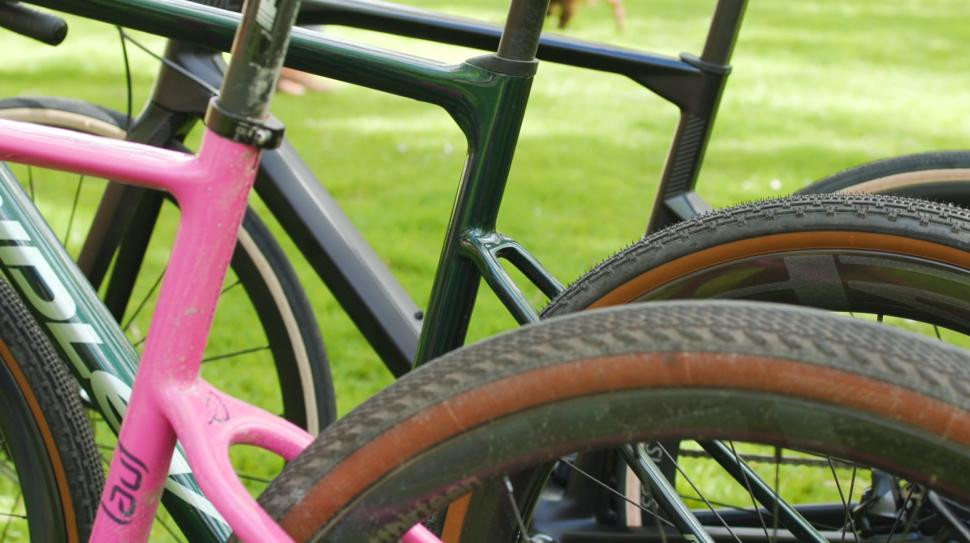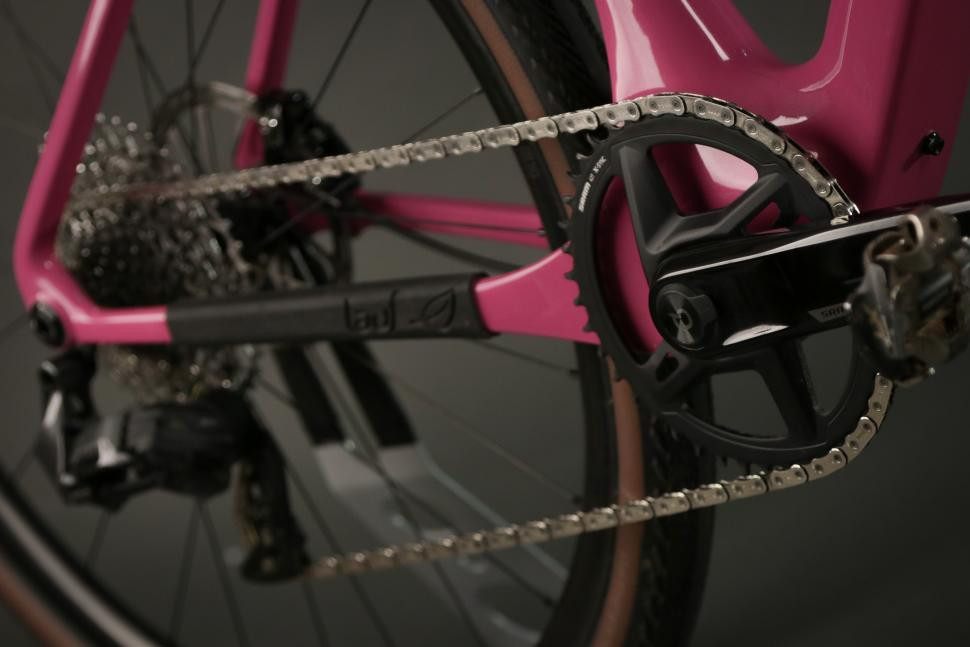Gravel bikes are incredibly versatile, and many riders wonder if they can effectively replace a dedicated road bike. At usabikers.net, we’re here to give you the lowdown: gravel bikes can be used as road bikes, though there are trade-offs in speed and efficiency. Keep reading to explore the nuances, performance differences, and whether a gravel bike suits your road riding needs. Consider this your ultimate resource for all things cycling!
1. Understanding the Gravel Bike Revolution
Gravel bikes have surged in popularity, offering a blend of versatility that traditional road bikes lack. But what makes them so appealing, and can they truly bridge the gap between off-road adventures and smooth tarmac?
1.1. What Exactly is a Gravel Bike?
A gravel bike is designed to handle a variety of surfaces, from paved roads to gravel paths and even light trails. They typically feature a more relaxed geometry than road bikes, wider tire clearance, and sturdy frames. This makes them comfortable and capable on diverse terrains.
1.2. Key Features That Define a Gravel Bike
- Frame Geometry: Gravel bikes often have a longer wheelbase and slacker head tube angle for stability.
- Tire Clearance: They can accommodate wider tires, typically ranging from 35mm to 50mm or more.
- Brakes: Disc brakes are standard, providing reliable stopping power in all conditions.
- Mounting Points: Multiple mounts for racks, fenders, and bottles enhance their utility for touring and commuting.
- Gearing: Wide-range gearing helps tackle steep climbs and varied terrain.
1.3. The Rise of the Do-It-All Bike
The appeal of gravel bikes lies in their ability to handle almost any terrain. This “one-bike-garage” concept is particularly attractive to riders who want a versatile machine without the need for multiple specialized bikes.
2. Road Bike vs. Gravel Bike: Dissecting the Differences
To understand whether a gravel bike can function as a road bike, it’s essential to compare the two types in terms of geometry, components, and overall performance.
2.1. Geometry: Comfort vs. Speed
Road bikes typically have a more aggressive, aerodynamic geometry designed for speed and efficiency. Gravel bikes prioritize comfort and stability, with a more upright riding position.
2.2. Components: Gearing, Brakes, and More
Road bikes often feature tighter gearing ratios for optimal cadence on smooth roads, while gravel bikes have wider gear ranges for varied terrain. Disc brakes are universal on gravel bikes, whereas road bikes may still use rim brakes in some cases.
2.3. Tire Size and Tread: The Most Obvious Distinction
Road bikes are designed for narrow tires (23mm-32mm) with minimal tread for low rolling resistance. Gravel bikes use wider tires (35mm-50mm+) with more pronounced tread patterns for grip on loose surfaces.
 2023 gravel bike vs allroad bike vs road bike rear tyres
2023 gravel bike vs allroad bike vs road bike rear tyres
2.4. Weight: How Much Does It Matter?
Generally, gravel bikes are slightly heavier than road bikes due to their sturdier frames and wider tires. However, the weight difference may not be significant enough to deter riders from using a gravel bike on the road.
2.5. Aerodynamics: Slicing Through the Wind
Road bikes are designed with aerodynamics in mind, featuring sleek frames and components to minimize wind resistance. Gravel bikes, with their more upright riding position and wider tires, are less aerodynamic.
3. Performance on Pavement: Can Gravel Bikes Keep Up?
The key question is: how well do gravel bikes perform on paved roads compared to road bikes? Let’s delve into various performance metrics.
3.1. Speed and Efficiency: The Numbers Don’t Lie
In a test conducted by road.cc, a gravel bike was found to be approximately 1.24kph slower than a road bike on a flat course at a constant power output of 275 watts. This difference may seem small, but it can add up over longer rides.
3.2. Rolling Resistance: The Impact of Tire Choice
Rolling resistance is a significant factor affecting speed. Gravel tires, with their wider profile and tread, generally have higher rolling resistance than road tires. Websites like bicycle rolling resistance.com provide data on tire performance. According to their tests, even the fastest gravel tires can be around 10 watts slower per tire at 28.8kph compared to road tires.
3.3. Climbing: Weight and Gearing Considerations
While gravel bikes may be slightly heavier, the impact on climbing performance is marginal. The road.cc test showed only a minimal difference in climbing speed between a gravel bike and a road bike, provided the power output is consistent.
3.4. Descending: Aerodynamics and Control
On descents, road bikes tend to be faster due to their aerodynamic advantages. Wider bars and a more upright position on a gravel bike can increase frontal area, leading to greater wind resistance.
3.5. Comfort: A Key Advantage for Long Rides
Gravel bikes often offer superior comfort compared to road bikes, thanks to their more relaxed geometry and wider tires. This can be a significant advantage for long rides or riders who prioritize comfort over outright speed.
4. The Versatility Factor: Where Gravel Bikes Shine
Despite some performance drawbacks on pavement, gravel bikes offer unparalleled versatility. This makes them an excellent choice for riders who want a bike that can handle a variety of conditions.
4.1. Mixed Terrain Adventures: The Best of Both Worlds
Gravel bikes excel on rides that combine paved roads with gravel paths, dirt trails, or even light singletrack. This versatility allows riders to explore new routes and enjoy varied terrain without needing to switch bikes.
4.2. Commuting: Comfort and Practicality
The comfort, stability, and mounting points of gravel bikes make them ideal for commuting. Wider tires provide a smoother ride over rough roads, and the ability to carry racks and fenders adds practicality.
4.3. Touring: Exploring Beyond the Pavement
Gravel bikes are well-suited for touring, allowing riders to venture onto unpaved roads and explore remote areas. Multiple mounting points for luggage and water bottles make them capable adventure machines.
4.4. Exploring New Routes: Freedom to Roam
One of the greatest advantages of a gravel bike is the freedom to explore new routes without being limited to paved roads. This opens up a world of possibilities for adventurous riders.
5. Optimizing Your Gravel Bike for Road Riding
If you plan to use your gravel bike primarily on the road, there are several ways to optimize its performance.
5.1. Tire Selection: Rolling Resistance Matters
Switching to smoother, narrower tires can significantly reduce rolling resistance and improve speed on pavement. Options like the Schwalbe G-One Speed or Continental Grand Prix 5000 S TR offer a good balance of speed and comfort.
5.2. Tire Pressure: Finding the Sweet Spot
Proper tire pressure can also affect rolling resistance and comfort. Experiment with different pressures to find the optimal balance for your weight and riding style. SRAM’s online tire pressure calculator is a helpful resource.
5.3. Gearing: Maximizing Efficiency
Consider adjusting your gearing to better suit road riding. A 2x drivetrain can provide tighter gear ratios for optimal cadence on smooth roads.
5.4. Aerodynamics: Position and Components
While you can’t completely transform a gravel bike into a road bike, you can improve aerodynamics by adopting a more aggressive riding position and using aerodynamic components like drop bars.
5.5. Bike Fit: Ensuring Comfort and Efficiency
A professional bike fit can help optimize your position on the bike for both comfort and efficiency. This is especially important if you plan to ride long distances on the road.
6. Real-World Scenarios: When a Gravel Bike Makes Sense on the Road
Let’s look at some specific scenarios where using a gravel bike on the road is a practical choice.
6.1. Group Rides: Staying Competitive
While a gravel bike may be slightly slower, it can still be used for group rides, especially if you’re willing to work a bit harder. Hiding behind other riders can help minimize the aerodynamic disadvantage.
6.2. Commuting: Navigating City Streets
A gravel bike is an excellent choice for commuting, providing comfort and stability on rough city streets. The ability to hop curbs and navigate potholes without worry is a significant advantage.
6.3. Fitness and Training: Versatile Workouts
Gravel bikes can be used for a variety of fitness and training activities, from long endurance rides to interval training. The versatility of the bike allows you to mix up your workouts and keep things interesting.
6.4. One-Bike-Garage: Simplicity and Convenience
For riders who want a single bike that can handle a variety of conditions, a gravel bike is a great choice. It simplifies bike ownership and maintenance while still providing a capable and versatile ride.
6.5. Budget Considerations: Getting the Most for Your Money
If you’re on a budget, buying a gravel bike can be a cost-effective way to get a bike that can handle both road and off-road riding. This eliminates the need to purchase and maintain two separate bikes.
7. Addressing Common Concerns and Misconceptions
Let’s tackle some common questions and misconceptions about using gravel bikes on the road.
7.1. “Gravel Bikes Are Too Slow on the Road”
While gravel bikes may be slightly slower than road bikes, the difference is often smaller than people expect. With the right tires and setup, a gravel bike can be surprisingly fast on pavement.
7.2. “Gravel Bikes Are Uncomfortable on Long Road Rides”
On the contrary, many riders find gravel bikes to be more comfortable than road bikes on long rides. The more relaxed geometry and wider tires provide a smoother, more forgiving ride.
7.3. “Gravel Bikes Are Only for Off-Road Riding”
Gravel bikes are designed to be versatile, and they can be used for a variety of riding styles, including road riding. They’re not just for off-road adventures.
7.4. “I’ll Get Dropped on Group Rides If I Use a Gravel Bike”
With the right effort and strategy, you can definitely keep up on group rides with a gravel bike. Hiding behind other riders and choosing a fast tire setup can help minimize any performance disadvantage.
7.5. “Gravel Bikes Are Too Heavy for Climbing”
While gravel bikes may be slightly heavier, the impact on climbing performance is often minimal. Strong legs and a good climbing strategy are more important than a few extra grams.
8. The Verdict: Are Gravel Bikes Suitable for Road Riding?
So, Can Gravel Bikes Be Used As Road Bikes? The answer is a resounding yes, with some caveats. While they may not be as fast or aerodynamic as dedicated road bikes, gravel bikes offer a compelling blend of versatility, comfort, and practicality.
8.1. Weighing the Pros and Cons
Pros:
- Versatility: Capable of handling a variety of terrain
- Comfort: More relaxed geometry and wider tires
- Practicality: Mounting points for racks and fenders
- Durability: Sturdier frames for rough conditions
- Exploration: Freedom to explore new routes
Cons:
- Speed: Slightly slower than road bikes on pavement
- Aerodynamics: Less aerodynamic than road bikes
- Weight: Generally heavier than road bikes
8.2. Making the Right Choice for Your Needs
Ultimately, the decision of whether to use a gravel bike as a road bike depends on your individual needs and priorities. If you value versatility, comfort, and the ability to explore new routes, a gravel bike is an excellent choice. If you prioritize speed and aerodynamics above all else, a dedicated road bike may be a better option.
8.3. The Future of Cycling: Blurring the Lines
As cycling technology continues to evolve, the lines between different types of bikes are becoming increasingly blurred. Gravel bikes are leading the charge in this evolution, offering riders a do-it-all machine that can handle almost any adventure.
9. Call to Action: Join the usabikers.net Community
Ready to explore the world of gravel bikes and road riding? Visit usabikers.net for in-depth reviews, expert advice, and a vibrant community of fellow riders. Whether you’re a seasoned cyclist or just starting out, we have something for everyone.
9.1. Explore Our Bike Reviews and Guides
Discover detailed reviews of the latest gravel bikes and road bikes, along with comprehensive guides on components, accessories, and riding techniques.
9.2. Join Our Thriving Forum
Connect with other riders, share your experiences, and ask questions in our active forum. Our community is a welcoming and supportive place for cyclists of all levels.
9.3. Share Your Riding Experiences
We encourage you to share your own riding experiences, whether it’s a local group ride, a challenging climb, or a scenic tour. Your stories and insights can inspire and inform other riders.
9.4. Stay Updated on the Latest News and Events
Keep up-to-date with the latest news, events, and trends in the cycling world. We cover everything from new bike releases to local races and festivals.
9.5. Contact Us for Personalized Advice
Have a specific question or need personalized advice? Our team of experts is here to help. Contact us through our website or social media channels, and we’ll do our best to assist you.
10. Frequently Asked Questions (FAQs)
10.1. Can a gravel bike be as fast as a road bike?
No, a gravel bike is generally not as fast as a road bike on paved surfaces due to factors like tire rolling resistance and aerodynamics. However, the speed difference can be minimized with the right tire choice and setup.
10.2. Are gravel bikes good for long road rides?
Yes, gravel bikes can be excellent for long road rides, offering a more comfortable and stable ride compared to traditional road bikes. The relaxed geometry and wider tires help reduce fatigue and improve overall comfort.
10.3. What type of tires should I use if I plan to ride my gravel bike mostly on the road?
For primarily road use, consider smoother, narrower tires like the Schwalbe G-One Speed or Continental Grand Prix 5000 S TR. These tires offer lower rolling resistance and improved speed on pavement.
10.4. How does the weight of a gravel bike affect its performance on the road?
While gravel bikes are generally heavier than road bikes, the weight difference has a relatively small impact on performance, especially on flat or rolling terrain. However, on steep climbs, the extra weight may be more noticeable.
10.5. Can I use a gravel bike for commuting in the city?
Yes, gravel bikes are an excellent choice for commuting in the city, offering comfort, stability, and the ability to navigate rough roads and obstacles with ease.
10.6. What are the key differences between gravel bikes and road bikes?
Key differences include frame geometry (more relaxed on gravel bikes), tire clearance (wider on gravel bikes), and components (wider gear ranges on gravel bikes).
10.7. How does tire pressure affect the performance of a gravel bike on the road?
Proper tire pressure can significantly affect rolling resistance and comfort. Experiment with different pressures to find the optimal balance for your weight and riding style.
10.8. Is it possible to convert a road bike into a gravel bike?
While it’s possible to make some modifications to a road bike to make it more gravel-friendly, it’s generally not recommended to try to convert a road bike into a dedicated gravel bike. The frame geometry and tire clearance are key design elements that cannot be easily changed.
10.9. Are gravel bikes more durable than road bikes?
Yes, gravel bikes are generally more durable than road bikes, thanks to their sturdier frames and components designed to withstand rough conditions.
10.10. What are the best gravel bike brands for road riding?
Some popular gravel bike brands known for their road-friendly models include Specialized, Trek, Canyon, and Giant. Look for models with versatile geometry and the ability to accommodate smoother, narrower tires.
 Lauf Seigla Weekend Warrior Wireless RCCR-3
Lauf Seigla Weekend Warrior Wireless RCCR-3
Join us at usabikers.net and become part of a community that celebrates the freedom, adventure, and camaraderie of motorcycle culture. Explore our articles, connect with fellow enthusiasts, and gear up for your next thrilling ride. Let usabikers.net be your ultimate pit stop! You can find us at 801 Sturgis Main St, Sturgis, SD 57785, United States, or give us a call at +1 (605) 347-2000. Visit our website usabikers.net today!

